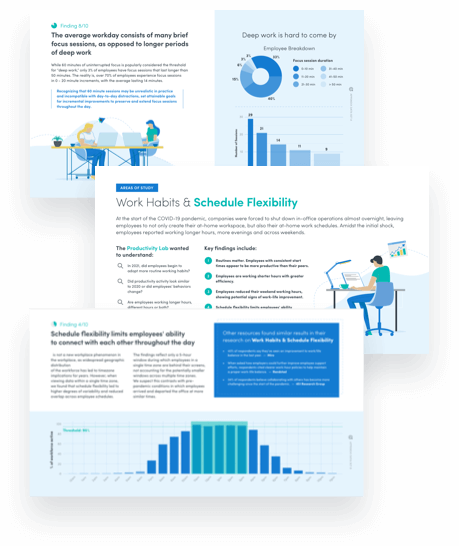At the start of the COVID-19 pandemic, companies were forced to shut down in-office operations almost overnight, leaving employees to not only create their at-home workspace, but also their at-home work schedules. Amidst the initial shock, employees reported working longer hours, more evenings and across weekends.
The Productivity Lab wanted to understand:
Key findings include:
Routines matter
Employees with consistent start times appear to be more productive than their peers.
Reduced weekend working hours
Employees reduced their weekend working hours, showing potential signs of work-life improvement.
Flexibility risks
Schedule flexibility limits employees’ ability to connect with one another throughout the day.
Finding 1/10
Routines matter. Employees with consistent start times appear to be more productive than their peers
Flexible work has left many unanswered questions for leaders and employees alike:
Is there such a thing as too much individual flexibility? Does the unpredictability of people’s schedules lead to daily operating challenges? Are people available when they’re needed by their peers?
The Productivity Lab found that far more individuals adopted some level of routine than expected. In fact, 70% of employees began their day within the same 2-hour window. The consistency of start-time behaviors reflects a clearer level of expectations set forth by employers and/or the presence of a stronger social norm associated with when to begin the day.
Digging deeper, the Lab wanted to understand if routine had an impact on employee productivity. It found that employees who consistently started their day within the same 2-hour window were an entire hour (18%) more productive than their peers who varied their morning starts across a 3-hour window.
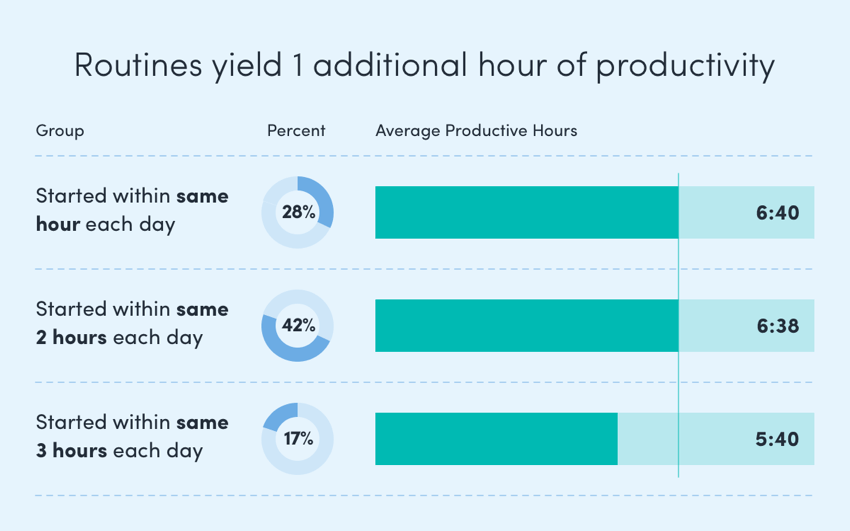
However, at the end of the day, there were much higher levels of end-time variability. This may be attributed to employees taking advantage of greater flexibility and choosing to flex later into the evening on certain days
versus others. Despite this variability, the findings do not suggest that less work is being done across the week.
Finding 2/10
Employees are working shorter hours with greater efficiency
While employees spent similar hours behind the screen in 2020 and 2021, in 2021 employees increased productive time by 40%, jumping from an average of 4:37 to 6:28 hours — one of the most substantial improvements comparing two years of pandemic data. The steep change could be attributed to a variety of workplace changes including:
– Organizations provided employees additional at-home tools to accommodate virtual productivity.
– Employees adjusted to at-home work and created working habits and spaces to allow for more productive practices
– The partial opening of the economy re-established efficiency benefits such as childcare options, co-working locations and partial to full office time.
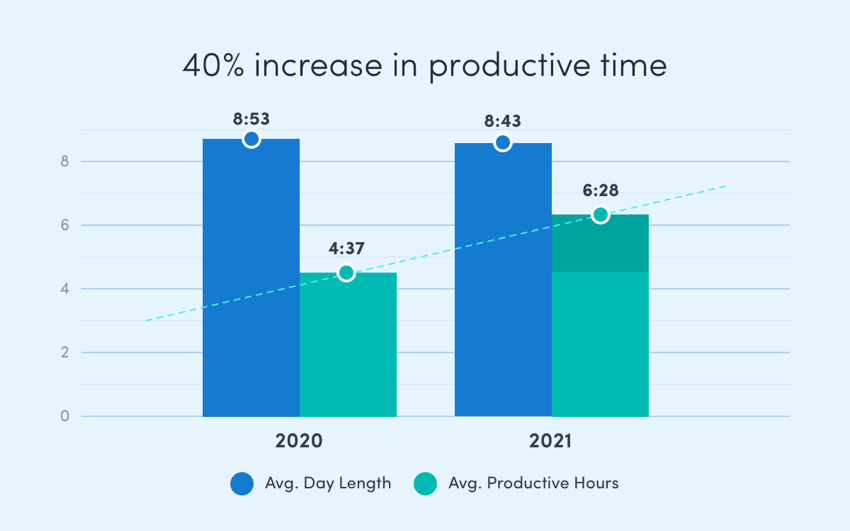
While we are optimistic about the improvements, we’re also keenly aware that too much efficiency can have a diminishing return on healthy productivity in the workplace.
Finding 3/10
Employees reduced their weekend working hours, showing potential signs of work-life balance improvement
Specific roles may require employees to work on weekends — or they may decide it is convenient to do so themselves. In the last year, the Productivity Lab found an 11% decrease in consistent weekend work activity. Routine weekend work behavior, specifically for non-shift work, can substantially contribute to employee strain and burnout.
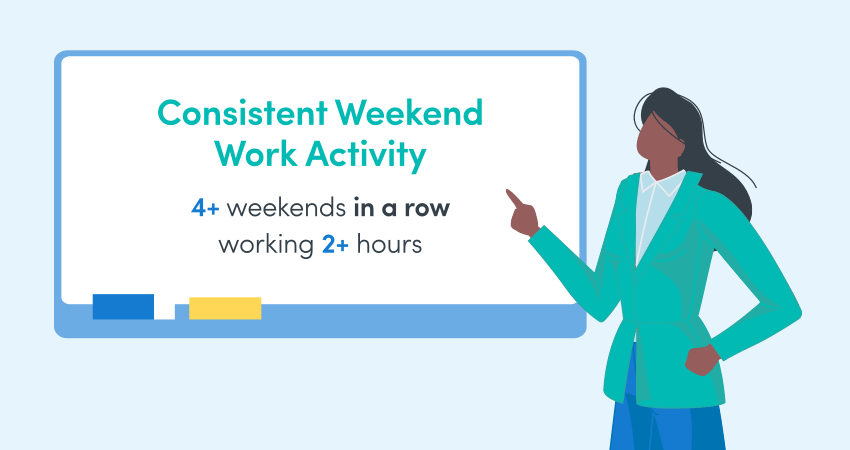
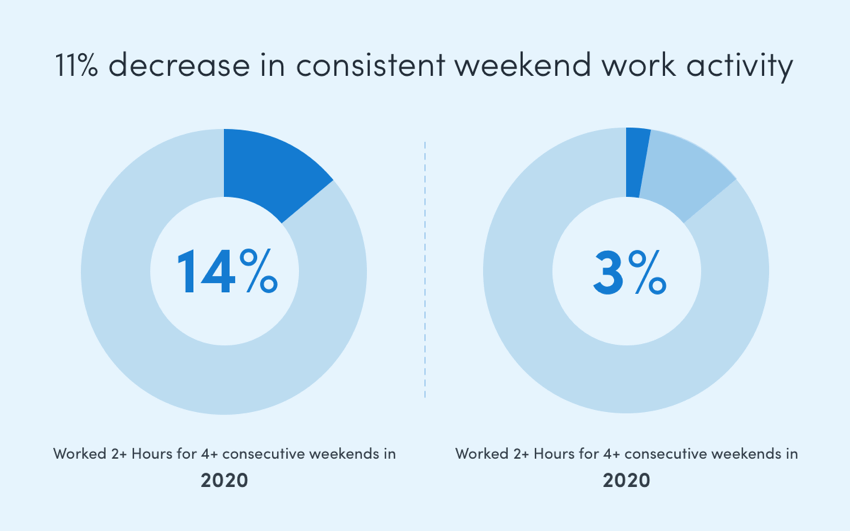
Finding 4/10
Schedule flexibility limits employees’ ability to connect with each other throughout the day
Schedule alignment is not a new workplace phenomenon in the workplace, as widespread geographic distribution of the workforce has led to timezone implications for years. However, when viewing data within a single time zone, we found that schedule flexibility led to higher degrees of variability and reduced overlap across employee schedules.
The findings reflect only a 5-hour window during which employees in a single time zone are behind their screens, not accounting for the potentially smaller windows across multiple time zones.
We suspect this contrasts with pre-pandemic conditions in which employees arrived and departed the office at more similar times.
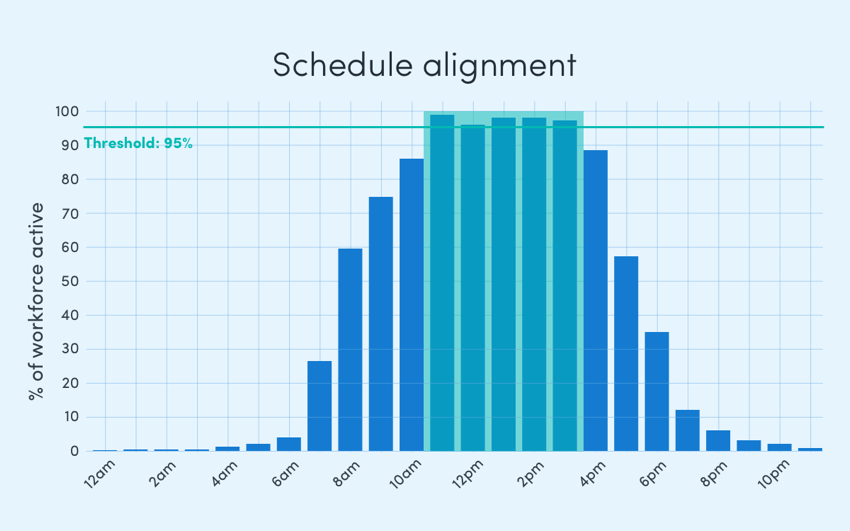
Other resources found similar results in their research on Work Habits & Schedule Flexibility
- 43% of respondents say they’ve seen an improvement to work/life balance in the last year. — Miro
- When asked how employers could further improve employee support efforts, respondents cited clearer work-hour policies to help maintain a proper work-life balance. — Randstad
- 34% of respondents believe collaborating with others has become more challenging since the start of the pandemic. — 451 Research Group
References
-
Miro. (2021, March). A Year of Remote Work: A look into the work from home experience.
https://miro.com/blog/remote-work-survey/ -
Randstad. (2021). Randstad Workmonitor: 2021 First Edition.
https://workforceinsights.randstad.com/hr-research-reports/workmonitor-2021-first-edition -
Forrest, C., Marsh, C., Castañón-Martínez, R., & Jimenez, R. (2020, December). 2021 Trends in Workforce Productivity & Collaboration. 451 Research.
Get the Full Report
Click the button below to access a downloadable PDF!
